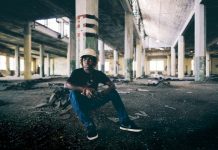
Richard Avedon, Fashion Photographs 1944-2000, opens Oct. 18 and runs through Jan. 17 at the Detroit Institute of Arts. Curator Nancy Barr talked with Hour Detroit about the significance of Avedon.
Avedon worked with celebrities and collaborated with noted authors, yet he was drawn to unorthodox beauty. You can imagine he had a love-hate relationship with fame and the status quo of popular culture.
I think he was suspicious of the powers that were in charge of the magazine — critical of the way they controlled the image-making and controlled what they published. He worked with James Baldwin on a book called Nothing Personal, in which he photographed civil-rights people like Dr. King. That was right around the time he started looking for African-American models and started trying to expand that idea of beauty and what beauty was in fashion layouts. Once he got a footing in the business, he realized that he might have a say in what got into the pages.
Are all of the prints in the exhibition black and white?
I’d say the majority. Some of them are very old prints that he made at the time he actually made the photographs, so they’re rare. Then there’s a big later series [1995] that he did in color Iris prints. He used a digital file and he output that on an Iris printer and they’re really beautiful, very saturated watercolor-look photographs.
In doing your research, what did you come to appreciate about Avedon?
How fascinating he found women to be. He said [paraphrasing a quote] fashion dressmakers lent me their textures, their fabrics, and their styles, but it was always about women, what’s in their mind, what’s in their heads.
There seems to be a fondness for women that comes through in his work. We’ve all seen photographs where the photographer doesn’t seem to like women much.
Right. They make them look bad. But he seems to be very curious about [femininity] and very much inspired by it. The [new book, Avedon Fashion] talks about his dad being in the clothing business and his mom and sister being very fashionable and how he would watch them get ready — the whole process of how they constructed their appearances.
The exhibition photos are from the Avedon estate. Do many private collectors and museums have his work?
We have one of his fashion pictures [in the DIA collection]. Other big museums do, too. The thing about that mid-century fashion work and magazine work in general was that, at that time, there weren’t really venues for photographers to edition prints and sell prints through galleries. That came later in the 1970s. He did edition things later in his career and have gallery shows and sell material. But it’s not like there’s tons of his work out there on the market.
The show includes personal items, such as what?
There’s a whole group of vintage engraver’s prints that he found when he was moving his studio in around 2000. And those are 8-by-10 prints on cardboard mounts and they have stamps and notations by his art director [Alexey Brodovitch] and editor Carmel Snow, and by him on the margins.
I read that he did nearly every cover for Vogue until Anna Wintour came [as editor]. Did they not get along?
I’m not sure what the behind-the-scenes story was, but he shot a cover for her and she rejected it, so he decided he would just quit and move on. Maybe they didn’t see eye to eye, and he’d been there for so many years, since ’66. I think he left Vogue in ’88. He became a staff photographer for The New Yorker and did some fashion folios for them. A couple of those are in the exhibition.
Do you see any comparison with Annie Leibovitz, and where would you place Avedon among fairly recent photographers?
He’d have to be in the top five as an innovator, as somebody whose work was widely published and became very recognizable over the decades. Avedon came from a different era than Leibovitz. He worked with some very interesting people at Harper’s and that forged this whole new look for photography — not just in magazines, but in general.
He was into blurring and motion and throwing things out of focus, something that was not widely accepted at that time. He worked with [art director] Alexey Brodovitch, who’s a legend in the field. Brodovitch taught him to see things in a whole new way and bring brand-new types of images to the pages of magazines. And then Brodovitch cropped them and did all kinds of very dramatic things to them to make them even more compelling. [Leibovitz] is this known celebrity photographer and it’s kind of like stargazing when you look at her work.
Who else would you put in that top five?
Robert Frank. We’re actually doing a show of Robert Frank’s work in the spring. Walker Evans — he was very influential. Martin Munkacsi, a photojournalist in the 1930s. [Harper’s editor] Carmel Snow discovered him and started using him for fashion. Munkacsi shot outdoors [and] with available light. He got people out of the studio. He captured that unique fleeting moment; we call it the decisive moment photographic style. There’s actually a photograph in the exhibition called Homage to Martin Munkacsi. I’d also say Henri Cartier-Bresson or André Kertész and Diane Arbus.
Do you have a favorite photo in the exhibition?
I keep coming back to the Donyale Luna photograph. I’ve been researching her because she was from Detroit. As I look at it more and more, it’s kind of iconic. She’s wearing a Paco Rabanne dress. And she’s wearing it with gladiator sandals. It was very ahead of its time, and she was very ahead of her time.
She came out of a small theater group that was here in Detroit in the 1960s. Donyale was a big deal because she was one of the first African-American models. She was in Harper’s in ’65. We have that magazine in the exhibition.
Is there anything in fashion photography today that interests you?
Juergen Teller’s work for Marc Jacobs. He does really snapshot-like pictures of celebrities. He photographed Meg White for a Marc Jacobs accessory line, the handbags, a few years ago. They’re really strangely styled photographs.
|
|
|









